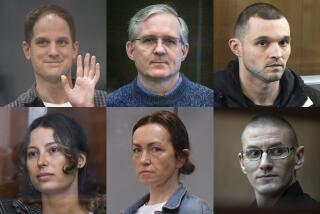Kremlin Shows ‘Bugs’ It Claims U.S. Planted
- Share via
MOSCOW — The Kremlin warmed up the espionage dispute with Washington Thursday by displaying a variety of electronic listening devices that it said had been planted by U.S. agents in Soviet diplomats’ offices and homes in Washington, New York and San Francisco.
Two days after President Reagan accused Soviet officials of “bugging” a new U.S. Embassy building in Moscow, a Foreign Ministry official showed the listening devices and other “material evidence” to reporters and said that the United States was clearly responsible.
The elaborate nature of the presentation, including not only microphones and transmitters but color photographs of them as well, suggested that it had been prepared well in advance.
Some ‘Bugs’ Called Recent
But a Soviet security official said that some of the devices had been removed from the new Soviet Embassy building in Washington only a few days ago. Other eavesdropping equipment was discovered long ago, in the 1970s, the official said.
The presentation was made at a press conference just four days before the scheduled arrival Monday of Secretary of State George P. Shultz for high-level talks on arms control and other issues.
Soviet spokesman Boris D. Pyadashev suggested that Shultz was not telling the truth when he said Wednesday at a press conference in Washington that “we did not break into their embassy--they invaded our sovereign territory.”
“It looks like a declaration that has nothing in common with the truth,” Pyadashev said.
He repeated Kremlin denials of U.S. charges that Soviet officials have saturated the new U.S. Embassy building here with listening devices.
In West Lafayette, Ind., where he made a speaking appearance Thursday, President Reagan was asked about the Soviet allegations that they were being bugged, too. “If you want to believe them, go ahead,” he told reporters.
When asked whether the United States indeed had tried to bug the Soviet Embassy, Reagan said: “I never discuss anything having to do with espionage or counterespionage.”
Later, he said: “You’ll all understand that I can’t and will not comment on United States intelligence. Nonetheless, I can say that what the Soviets did to our embassy in Moscow is outrageous, and we have protested strongly, and we’ll conduct a full investigation and take whatever corrective action is necessary. Diplomatic institutions . . . can and must be secured from Soviet spying.”
When a reporter told Reagan that he was leaving the impression that the United States had indeed bugged the Soviet Embassy, Reagan said: “I just said that we thought what they did was outrageous.”
Whose ‘Bugs’ Are Better?
At the Moscow press conference, Ivan N. Miroshkin, who was introduced to reporters as an official of the Soviet Security Service, was asked if the allegedly American devices were better or worse than their Soviet counterparts. Smiling broadly amid the reporters’ laughter, Miroshkin said he would leave it to the experts to make a technical comparison.
When another reporter asked who had installed more than 100 listening devices found recently in the Swedish Embassy here, Miroshkin refused to answer.
And Pyadashev refused to give a yes-or-no reply when asked if any Soviet citizen working on behalf of the Soviet government had placed listening devices in the present U.S. Embassy building here or the new embassy building still under construction.
Miroshkin said the devices that were reportedly found in Soviet facilities were manufactured by American firms, which he identified as Communications Control Systems and Electronic Systems of America. But some of the devices were so advanced and so small, he said, that they were probably produced by special laboratories.
Microphone Displayed
Among the devices exhibited were a microphone about the size of a pencil and transmitters concealed inside a wooden board. Miroshkin said that another system could transmit sounds by using a beam of light.
The Soviet officials charged that U.S. agents installed listening devices in the new residential building for Soviet diplomats in Washington as well as in the unfinished embassy building there.
Others, they said, were found in a recreational building on Chesapeake Bay, not far from Washington, as well as in living quarters for diplomats assigned to the Soviet mission in New York City.
At the Soviet Consulate in San Francisco, the officials said, a transmitter was found buried six feet below the building to relay conversations picked up by tiny microphones embedded in the walls.
‘Getting to Know You’
“Such methods of ‘getting to know you’ run counter to the norms of diplomatic immunity and are a violation of human rights,” Pyadashev said.
In a quiet, dispassionate voice, Pyadashev read a Foreign Ministry statement expressing “anger and indignation” at the alleged U.S. eavesdropping. Apparently referring to statements by Reagan and Shultz, the Soviet statement said:
“Why do high-placed representatives of the U.S. Administration . .perfectly aware of the actions of their intelligence services against the Soviet Union, try to cast aspersions and generate a new flare-up of runaway anti-Sovietism? It does not become political leaders to treat such serious matters with irresponsibility.”
The statement went on to say that “extremist, militarist, right-wing” forces in the United States are trying to spoil the atmosphere for any Soviet-American accord on arms control.
More to Read
Sign up for Essential California
The most important California stories and recommendations in your inbox every morning.
You may occasionally receive promotional content from the Los Angeles Times.









